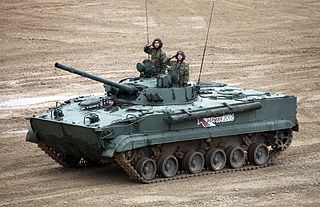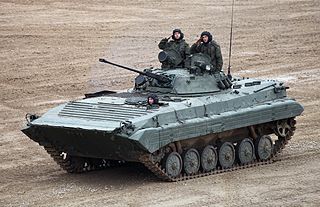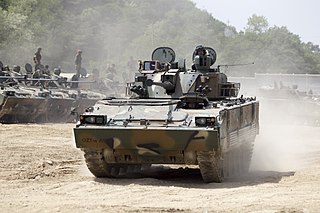
An infantry fighting vehicle (IFV), also known as a mechanized infantry combat vehicle (MICV), is a type of armoured fighting vehicle used to carry infantry into battle and provide direct-fire support. The 1990 Treaty on Conventional Armed Forces in Europe defines an infantry fighting vehicle as "an armoured combat vehicle which is designed and equipped primarily to transport a combat infantry squad, and which is armed with an integral or organic cannon of at least 20 millimeters calibre and sometimes an antitank missile launcher". IFVs often serve both as the principal weapons system and as the mode of transport for a mechanized infantry unit.

The BMP-3 is a Soviet and Russian infantry fighting vehicle, successor to the BMP-1 and BMP-2. The abbreviation BMP stands for boevaya mashina pehoty.

The BMP-1 is a Soviet amphibious tracked infantry fighting vehicle, in service 1966–present. BMP stands for Boyevaya Mashina Pyekhoty 1, meaning "infantry fighting vehicle, 1st serial model". The BMP-1 was the first mass-produced infantry fighting vehicle (IFV) of the Soviet Union. It was called the M-1967, BMP and BMP-76PB by NATO before its correct designation was known.

The BMP-2 is an amphibious infantry fighting vehicle introduced in the 1980s in the Soviet Union, following on from the BMP-1 of the 1960s.

The BMD-1 is a Soviet airborne amphibious tracked infantry fighting vehicle, which was introduced in 1969 and first seen by the West in 1970. BMD stands for Boyevaya Mashina Desanta. It can be dropped by parachute and although it resembles the BMP-1 it is in fact much smaller. The BMD-1 was used as an IFV by the Soviet Army's airborne divisions. An improved variant of the BMD-1 was developed, the BMD-2. The BMD-1 also provided a basis for the BTR-D airborne multi-purpose tracked APC.

The BMD-2 is a Soviet airborne infantry fighting vehicle, introduced in 1985. It is a variant of BMD-1 with a new turret and some changes done to the hull. BMD stands for Boyevaya Mashina Desanta.

The BMD-3 is a light infantry fighting vehicle originating in the Soviet Union that is fully amphibious and air-droppable with crew inside. It is intended to be used by airborne and air assault units. It is not an upgraded BMD-1 but a completely redesigned vehicle with a hydropneumatic suspension, new hull, a more powerful 2V-06-2 diesel engine and fitted with the complete turret of the BMP-2.

The K21 is a South Korean infantry fighting vehicle. A replacement for the K200-series, it was formerly designated as K300 or XK21 KNIFV. The initial production began in 2009, with the Republic of Korea Army planning to field approximately 466 units. It is designed to effectively defeat other IFVs as heavily armed and armored as the BMP-3.

The BMPT "Terminator" is an armored fighting vehicle (AFV), designed and manufactured by the Russian company Uralvagonzavod. This vehicle was designed for supporting tanks and other AFVs in urban areas. The BMPT is unofficially named the "Terminator" by the manufacturers. It is heavily armed and armored to survive in urban combat. The AFV is armed with four 9M120 Ataka missile launchers, two 30 mm 2A42 autocannons, two AG-17D grenade launchers, and one coaxial 7.62 mm PKTM machine gun.

The BTR-T is a Russian heavy APC, designed by the Design Bureau of Transport Machine-Building (Omsktransmash) state-run production association.

The BVP M-80, is a tracked Yugoslavian-made infantry fighting vehicle, produced from the 1980s until the country's collapse in the 1990s.

The MLI-84 is a tracked Romanian infantry fighting vehicle currently in service with the Romanian Land Forces. It was derived from the chassis of the Soviet BMP-1 but possessing a lengthened hull, a 12.7×108mm DShK 1938/46 heavy machine gun mounted on the roof of the troop compartment and MLI-84M having Oerlikon KBA autocannon and new ATGMs.
The Soviet BMP-1 is a tracked, amphibious infantry fighting vehicle (IFV) with a long service history.

The 2A28 Grom is the main armament of the BMP-1 and BMD-1 infantry fighting vehicles. It is a 73 mm low pressure smoothbore semi-automatic gun with a wedge breech block. Development of the 2A28 Grom was directly linked to that of the SPG-9 recoilless gun; both fired projectiles similar to rocket-propelled grenades.

The BMP series were among the first production line infantry fighting vehicles. Included in the series are the mainline BMPs, the airborne variant BMDs, and licensed modified and reverse engineered versions. BMP stands for Boyevaya Mashina Pekhoty, meaning "infantry fighting vehicle". They were initially developed in the 1960s in the Soviet Union.

The BMD-4 is an amphibious infantry fighting vehicle (IFV) originating from post-Cold War Russia. Originally designated as the BMD-3M, the chassis of the BMD-4 is the same as that of the BMD-3 because it was developed on the same basis. This armored fighting vehicle is one of the lightest in its class, possessing a substantial amount of firepower. The vehicle was designed to transport Russian Airborne Troops (VDV), increasing its mobility, armament, and protection on the battlefield.

The ATOM is a heavy 8×8 infantry fighting vehicle (IFV) jointly developed by the Russian company Petrel and the French company Renault Trucks. The vehicle is established on the basis of the French Véhicule blindé de combat d'infanterie (VBCI) IFV which is produced by Renault. The prototype of the ATOM was first unveiled during the 2013 Russian Arms Expo at Nizhny Tagil, equipped with a unique fighting module.

The T-15 Armata, with industrial designation "Object 149", is a Russian heavy infantry fighting vehicle first seen in public in 2015 during rehearsals for the Moscow Victory Day Parade. The T-15 concept of heavy IFV is derived from design of BTR-T vehicle that never entered military service. Existing BMP-3M is completely different vehicle, designed on the light tank chassis and is supposed to be succeeded by Kurganetz-25 platform.

The Type 86, also known as WZ501, is a Chinese copy of the Soviet BMP-1 and BMP-2 infantry fighting vehicle (IFV).


















